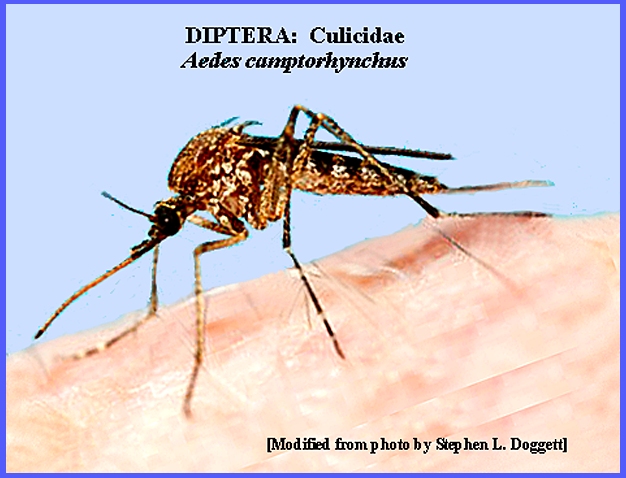File: <rossrivervirus.htm> <General Index> <General Index> Site Description Glossary <Navigate
to Home>
|
ROSS RIVER VIRUS (Contact) Please CLICK on
underlined links for details:
Aedes camptorhynchus,
the southern saltmarsh mosquito in New Zealand was a known vector, but an
eradication campaign has been deemed successful. Other mosquitoes in Australia that are suspected vectors
include Aedes camptorhynchus, Aedes vigilax and Culex annulirostris CONTROL Education of
the public living in or travelling to endemic areas is advised to minimise
exposure to mosquito bites.
Information should indicate the location of mosquito breeding
habitats, and when periods of maximum mosquito activity occur. Also, the use of protective clothing,
appropriate repellents and ways to reduce mosquitoes in the home can reduce
the incidence of infection. = = = = = = = = = = = =
= = = = = = = = Key References: <medvet.ref.htm> <Hexapoda> Barber, B., J. T.
Denholm & D. Spelman. 2009. Ross River virus. Australian Fam. Physician 38(8): 586-589. Fraser, J. R. 1986. Epidemic polyarthritis and Ross River virus disease. Clin. Rheum. Dis. 12: 369-388. Harley, D., A. Sleigh
& S. Ritchie. 2001. Ross River virus transmission, infection
and disease: a cross-disciplinary
review. Clin. Microbiol. Rev.14(4):
909-932. Harley, D., S. Ritchie,
C. Bain & A. C. Sleigh.
2005. Risks for Ross River
virus disease in tropical Australia.
Internatl. J. Epidemiology 34(3):
548-555. Jardine, A., P. J.
Neville, C. Dent, C. Webster & M. D. Lindsay. 2014. Ross River Virus
Risk Associated with Dispersal of Aedes
(Ochlerotatus) camptorhynchus
(Thomson) from Breeding Habitat into Surrounding Residential Areas: Muddy Lakes, Western Australia. Amer. Soc. Trop. Medicine & Hygiene 91: 101-108. Jardine, A., P. J.
Neville & M. D. Lindsay.
2015. Proximity to Mosquito
Breeding Habitat and Ross River Virus Risk in the Peel Region of Western Australia. Vector-Borne & Zoonotic Diseases: 141-146 Matheson, R. 1950. Medical Entomology. Comstock Publ. Co, Inc. 610 p. Service, M. 2008.
Medical Entomology For Students.
Cambridge Univ. Press. 289 p Legner, E. F. 1995. Biological control of Diptera of medical and veterinary
importance. J. Vector Ecology 20(1):
59_120. Legner,
E. F. 2000. Biological control of aquatic
Diptera. p. 847_870. Contributions to a Manual of Palaearctic
Diptera, Vol. 1, Science Herald, Budapest. 978 p. Russell, R. C. 2007. Ross River virus: ecology and
distribution. Ann. Rev. Entomol.
47: 1-31. Schleenvoigt, B. T.,
M. Baier, S. Hagel, C. Forstner, R. Kotsche & M. W. Pletz. 2015. Ross River virus infection in a Thuringian traveller returning from south-east
Australia. Infection 43(2): 229-230. Vally, H., M. Peel,
G. K. Dowse, J. P. Codde, I. Hanigan & M. D. Lindsay. 2012.
Geographic Information Systems used to describe the link between the risk of Ross River
virus infection and proximity to the Leschenault estuary, WA. Australian & New Zealand J. Pub. Health 36(3): 229-235. |
